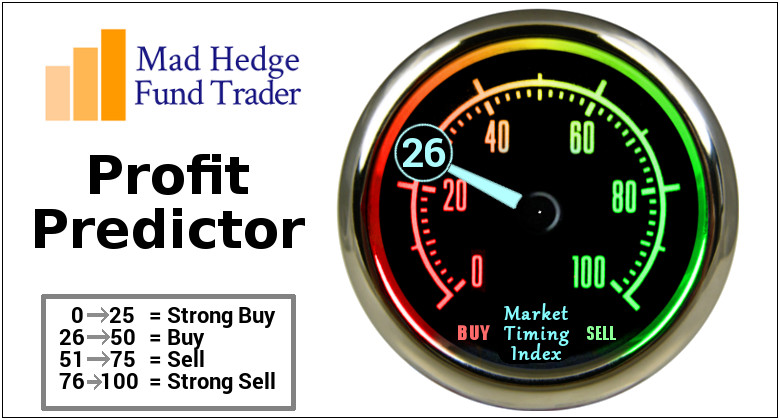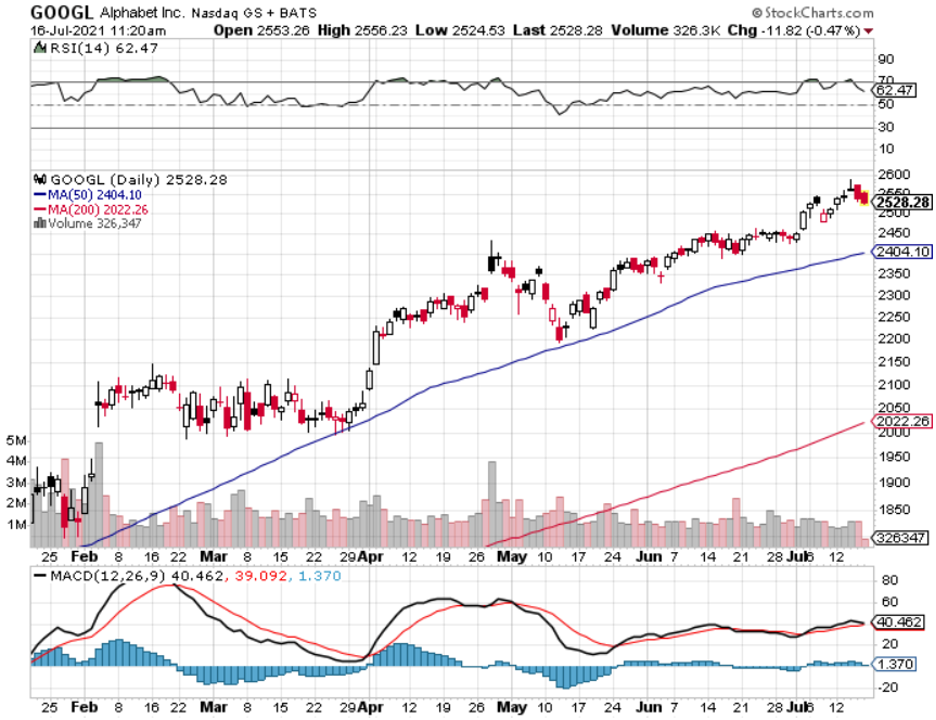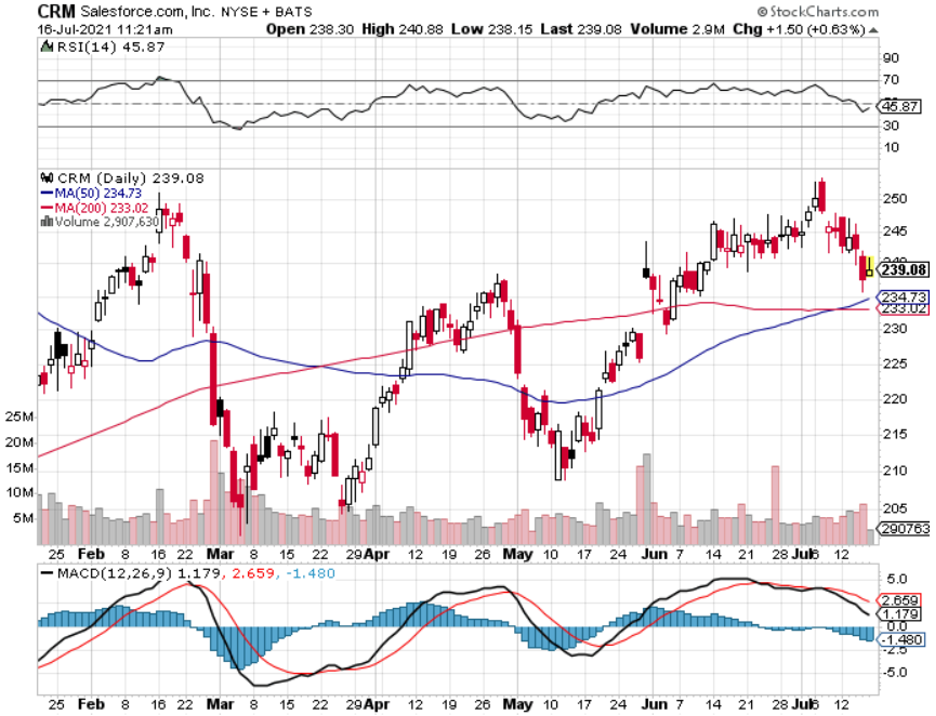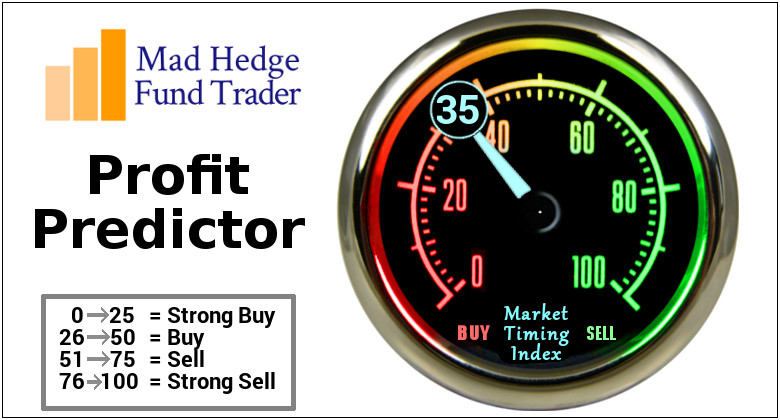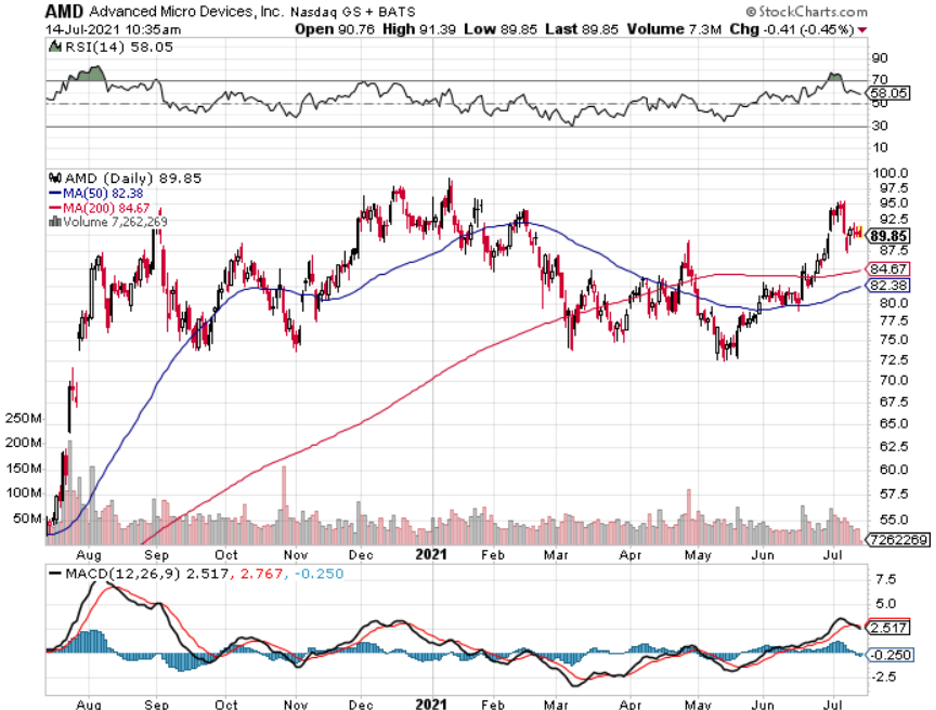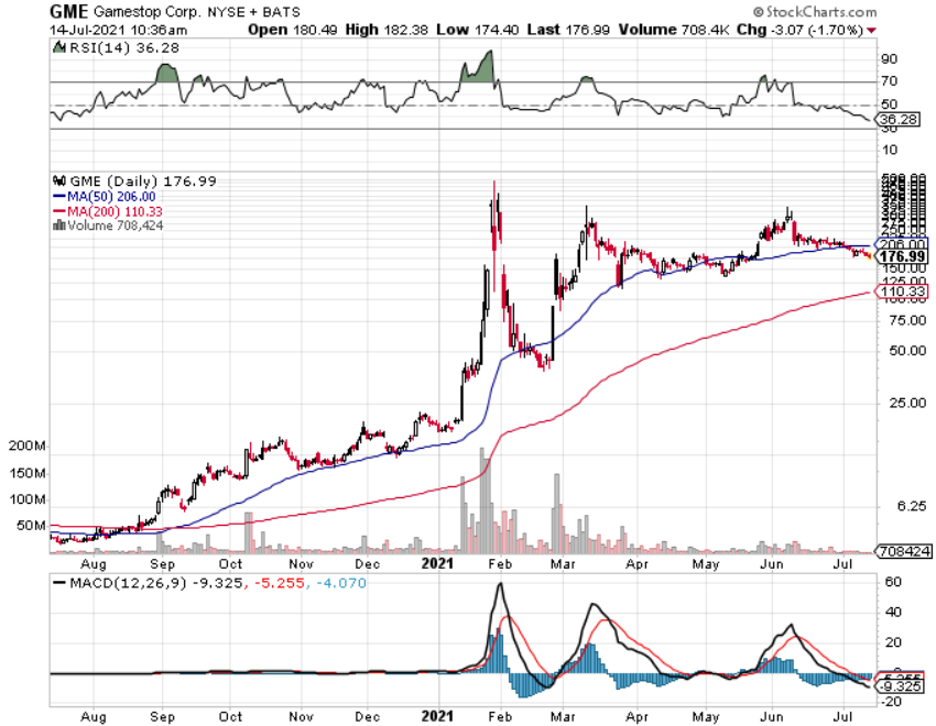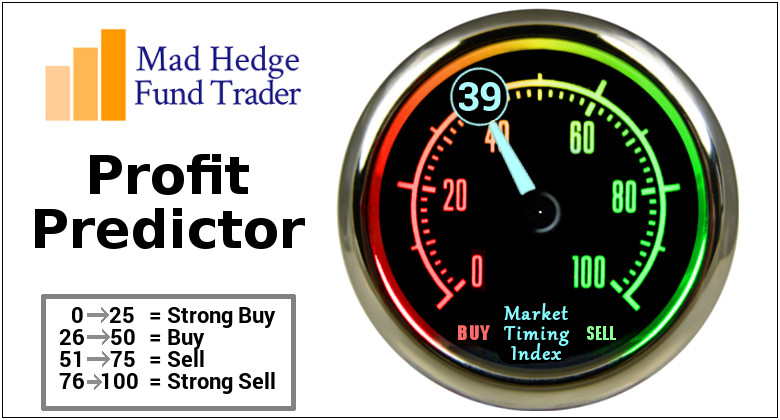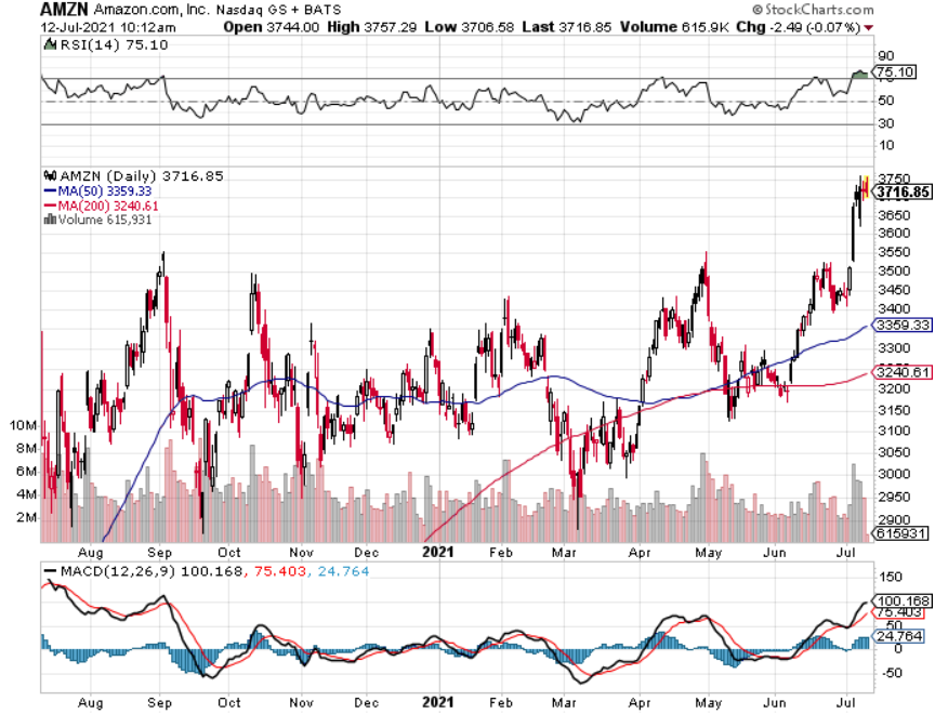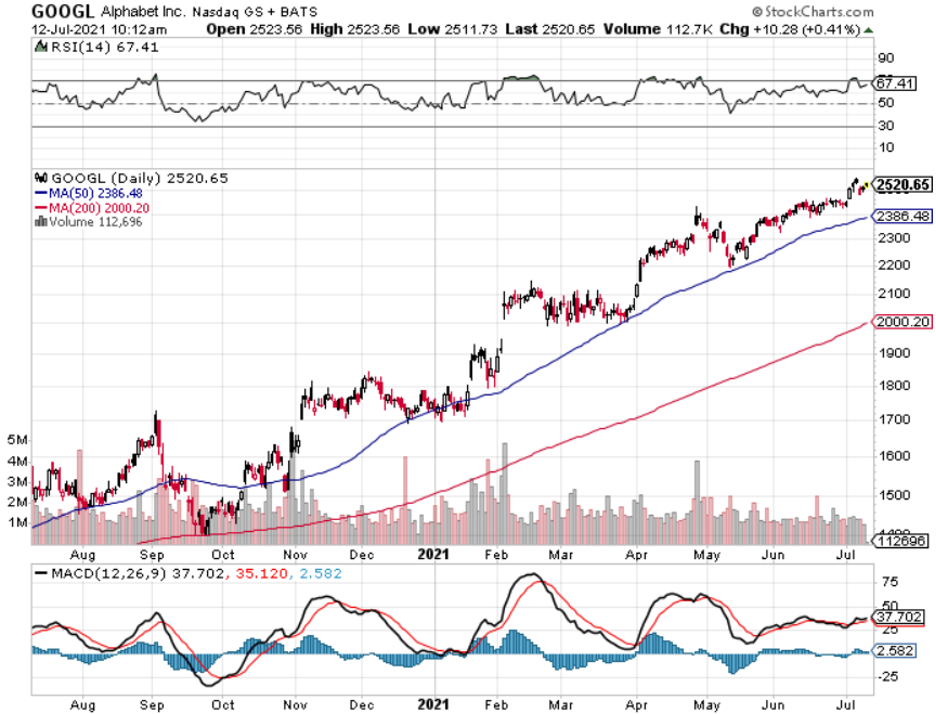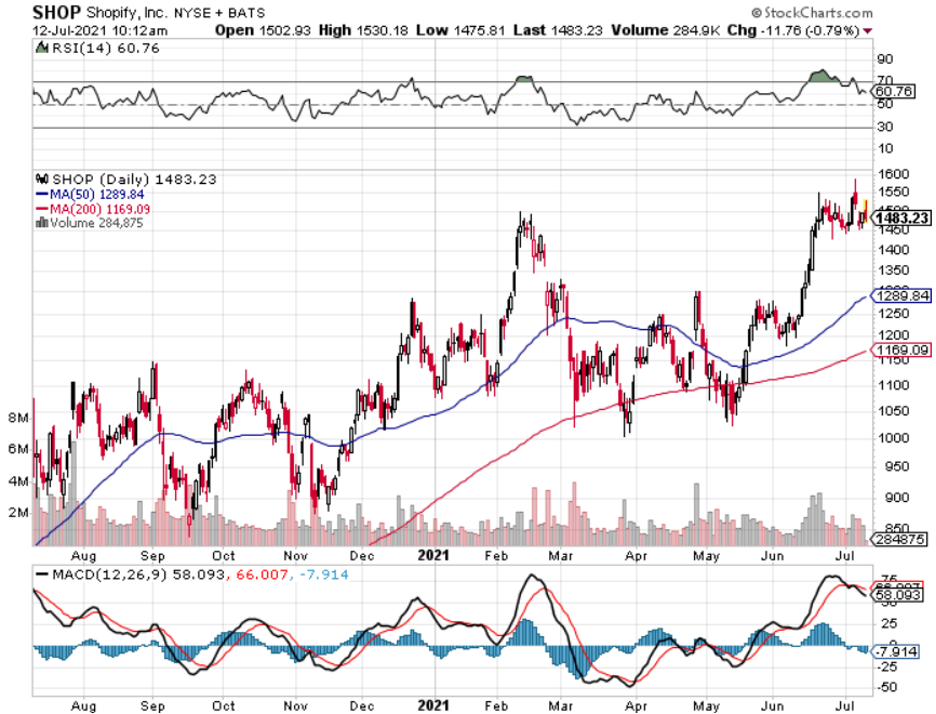“If GM had kept up with technology like the computer industry has, we would all be driving $25 cars that got 1,000 MPG.” – Said Co-Founder of Microsoft Bill Gates
Mad Hedge Technology Letter
July 16, 2021
Fiat Lux
Featured Trade:
(THE CLOUD)
(AMZN), (GOOGL), (CRM)
Dealing with the Cloud works and for every relevant tech company, this division serves as the pipeline to the CEO position.
If that’s not the case, then there’s something egregiously wrong!
Take Andy Jassy, the mastermind behind Amazon’s lucrative cloud computing division, and is the man who will succeed company founder Jeff Bezos.
He’s been rewarded this important business based on his performance in the cloud and faces a daunting proposition of following Bezos as CEO.
Bezos incorporated Amazon exactly 27 years ago.
Jassy developed a highly profitable and market-leading business, Amazon Web Services, that runs data centers serving a wide range of corporate computing needs.
Can you believe that Amazon's stock started out at $1.50 per share when adjusting for future equity splits?
It now trades at more than $3,500 per share and is worth over $1.8 trillion, making it one of the most valuable companies in the world.
Amazon's annual profit almost doubled in 2020 to $21.3 billion stoked by the pandemic that forced people to stay home and use Amazon services.
Consumers had no choice but to shop online, helping the company grow revenue 38% to $386.1 billion.
What exactly is the cloud that Amazon created?
Cloud 101
If you've been living under a rock the past few years, the cloud phenomenon hasn't passed you by and you still have time to cash in.
You want to hitch your wagon to cloud-based investments in any way, shape, or form.
Amazon leads the cloud industry it created.
It still maintains more than 30% of the cloud market. Microsoft would need to gain a lot of ground to even come close to this jewel of a business.
Amazon (AMZN) relies on AWS to underpin the rest of its businesses and that is why AWS contributes most of Amazon's total operating income.
Total revenue for just the AWS division would operate as a healthy stand-alone tech company if need be.
The future is about the cloud.
These days, the average investor probably hears about the cloud a dozen times a day.
If you work in Silicon Valley, you can quadruple that figure.
So, before we get deep into the weeds with this letter on cloud services, cloud fundamentals, cloud plays, and cloud Trade Alerts, let's get into the basics of what the cloud actually is.
Think of this as a cloud primer.
It's important to understand the cloud, both its strengths and limitations.
Giant companies that have it figured out, such as Salesforce (CRM) and Zscaler (ZS), are some of the fastest-growing companies in the world.
Understand the cloud and you will readily identify its bottlenecks and bulges that can lead to extreme investment opportunities. And that is where I come in.
Cloud storage refers to the online space where you can store data. It resides across multiple remote servers housed inside massive data centers all over the country, some as large as football fields, often in rural areas where land, labor, and electricity are cheap.
They are built using virtualization technology, which means that storage space spans across many different servers and multiple locations. If this sounds crazy, remember that the original Department of Defense packet-switching design was intended to make the system atomic bomb-proof.
As a user, you can access any single server at any one time anywhere in the world. These servers are owned, maintained, and operated by giant third-party companies such as Amazon, Microsoft, and Alphabet (GOOGL), which may or may not charge a fee for using them.
The most important features of cloud storage are:
1) It is a service provided by an external provider.
2) All data is stored outside your computer residing inside an in-house network.
3) A simple Internet connection will allow you to access your data at any time from anywhere.
4) Because of all these features, sharing data with others is vastly easier, and you can even work with multiple people online at the same time, making it the perfect, collaborative vehicle for our globalized world.
Once you start using the cloud to store a company's data, the benefits are many.
No Maintenance
Many companies, regardless of their size, prefer to store data inside in-house servers and data centers.
However, these require constant 24-hour-a-day maintenance, so the company has to employ a large in-house IT staff to manage them - a costly proposition.
Thanks to cloud storage, businesses can save costs on maintenance since their servers are now the headache of third-party providers.
Instead, they can focus resources on the core aspects of their business where they can add the most value, without worrying about managing IT staff of prima donnas.
Greater Flexibility
Today's employees want to have a better work/life balance and this goal can be best achieved by letting them working remotely which effectively happened because of the public health situation. Increasingly, workers are bending their jobs to fit their lifestyles, and that is certainly the case here at Mad Hedge Fund Trader.
How else can I send off a Trade Alert while hanging from the face of a Swiss Alp?
Cloud storage services, such as Google Drive, offer exactly this kind of flexibility for employees.
With data stored online, it's easy for employees to log into a cloud portal, work on the data they need to, and then log off when they're done. This way a single project can be worked on by a global team, the work handed off from time zone to time zone until it's done.
It also makes them work more efficiently, saving money for penny-pinching entrepreneurs.
Better Collaboration and Communication
In today's business environment, it's common practice for employees to collaborate and communicate with co-workers located around the world.
For example, they may have to work on the same client proposal together or provide feedback on training documents. Cloud-based tools from DocuSign, Dropbox, and Google Drive make collaboration and document management a piece of cake.
These products, which all offer free entry-level versions, allow users to access the latest versions of any document so they can stay on top of real-time changes which can help businesses to better manage workflow, regardless of geographical location.
Data Protection
Another important reason to move to the cloud is for better protection of your data, especially in the event of a natural disaster. Hurricane Sandy wreaked havoc on local data centers in New York City, forcing many websites to shut down their operations for days.
And we haven’t talked about the recent ransomware attacks by Eastern Europeans on energy company Colonial Pipeline and meat producer JBS Foods.
The cloud simply routes traffic around problem areas as if, yes, they have just been destroyed by a nuclear attack.
It's best to move data to the cloud, to avoid such disruptions because there your data will be stored in multiple locations.
This redundancy makes it so that even if one area is affected, your operations don't have to capitulate, and data remains accessible no matter what happens. It's a system called deduplication.
Lower Overhead
The cloud can save businesses a lot of money.
By outsourcing data storage to cloud providers, businesses save on capital and maintenance costs, money that in turn can be used to expand the business. Setting up an in-house data center requires tens of thousands of dollars in investment, and that's not to mention the maintenance costs it carries.
Plus, considering the security, reduced lag, up-time and controlled environments that providers such as Amazon's AWS have, creating an in-house data center seems about as contemporary as a buggy whip, a corset, or a Model T.
Now you might digest somewhat how Amazon built their share price from $1.50 in 1997 to over $3,500 today.
Thanks to the cloud.
“Life is not fair; get used to it.” - Said the Founder of Microsoft Bill Gates
Mad Hedge Technology Letter
July 14, 2021
Fiat Lux
Featured Trade:
(WHAT’S THE DEAL WITH MEME MANIA?)
(GME), (AMC), (WISH), (CLOV), (BB)
Although poor long-term investments, meme mania captured the imaginations of short-term traders with its wicked price action.
The counterculture drumbeat of taking down the institutions was then usurped by the meme management who issued shares after any sort of short squeeze.
Onlookers had to know the energy would not last and it is finally dying down.
Euphoric moments minted traders who benefited from unusual price spikes when institutions were caught off guard and had to buy the stock back at outrageous prices.
It appears as if this stage of meme mania is at the dying embers, and a sell the rally pattern has emerged in the past month just as big tech has accelerated its lead over everyone else.
For short-term traders, executing directional bearish bets is still on the table and for long-term buyers, you never should hold any of these following companies.
This type of smash and grab philosophy was just too risky for the Mad Hedge Technology portfolio and we avoided it like the plague.
I saw this more as a byproduct of too much liquidity in the system than anything else.
The stocks which skyrocketed were, in most cases, failed business models and only specific anomalies helped price action spin their way.
Since the volume has fallen off a cliff, the sell the rally would be the logical way to go for all the risk-takers who missed out on the meme mania phenomenon on the way up.
Here are the stocks involved.
Clover Health Investments, Corp. (CLOV) operates as a health insurer. It recently said it would be expanding insurance plans across nine states and more than 200 new counties in a bid to focus on underserved communities. The share price of the firm soared 8% after the announcement.
BlackBerry Limited (BB) provides intelligent security software and services to enterprises and governments worldwide. The company leverages artificial intelligence and machine learning to deliver solutions in the areas of cybersecurity, safety, and data privacy.
It is placed fourth a list of 10 Reddit’s WallStreetBets meme stocks hedge funds are piling into.
The company’s shares have returned 145% to investors in the past twelve months.
The company announced that the QNX software marketed by the firm was now installed in close to 200 million vehicles worldwide. This is an increase of 20 million compared to last year.
ContextLogic Inc. (WISH) is a California-based mobile ecommerce firm.
It is ranked third on a list of 10 Reddit’s WallStreetBets meme stocks hedge funds are piling into.
On July 6, the company announced that ContextLogic B.V, the Dutch arm of the business, had been granted a payment license for the European Union region. The share price of the firm jumped more than 5% after the announcement, which a company official said was the first step towards becoming a payment service provider in Europe.
GameStop (GME) rose from $4 to $325 and currently sits at $180.
The stock has continued to trend down from $320 after the latest short-squeeze and momentum is strongly biased towards the downside.
The retail company sells video games and has a terrible business model.
The last one is AMC Entertainment Holdings, Inc. (AMC) whose stock went from $2 to $60 and now is back down to $40.
AMC was a headliner disaster during the pandemic because movie theatres were closed and consumers were substituting their services for Netflix or other streaming services.
The Chinese property tycoon Wang Jianlian who bought into AMC before the pandemic was able to exit from his investment with a $675 million gain.
He acquired the company applying $1.9 billion of debt in 2012.
The Wanda Conglomerate was bailed out by the Reddit trading army after his vision of making AMC a “true global cinema operator” fizzled out big time.
The cinema chain reported a net loss of $4.6 billion for 2020, thus it’s stunning that Wang was able to spin such a disastrous investment for a tidy profit.
The AMC stake sale is the latest instance of Wanda offloading assets under pressure from Beijing, which wants Chinese to pare back its overseas holdings and debt.
The company was placed on a watch list by regulators in 2017 along with Anbang Group, Fosun Group, and HNA Group. These privately controlled Chinese conglomerates had accumulated some of the world’s largest debts after snapping up overseas trophy assets, often at premium prices, and were facing significant debt maturities.
Wang got lucky but the annual 2020 losses highlight the extent to how bad these business models are and how fortunate they were to have received a bailout from retail traders.
I believe these stocks are good for a short-term directional bearish bet with a controlled stop-loss strategy if things go sour fast.
None of these are worth owning, there are just too many other items on the menu that are tastier in a roaring U.S. economy.
From a wider-angle lens, the stock frenzy has fueled a record flow of money into the market from retail investors.
Only just last month, traders bought almost $28 billion of stocks and exchange-traded funds on a net basis, the largest amount in a single month since at least 2014.
This surely means that this new source of investment flows has gone into big tech with its huge surges higher.
At some point, capital will find itself in a different part of the equity market again and the Reddit army will be resuscitated basically because too many of them took profits and will be able to roll those profits into new positions.
Don’t get dragged into the mud looking for an easy buck.
Mad Hedge Technology Letter
July 12, 2021
Fiat Lux
Featured Trade:
(RIDE THE MOMENTUM)
(SHOP), (NFLX), (FB), (AMZN), (GOOGL), (NFLX), (AAPL), (MSFT)
Just as millions of people in the United States are sensing that life has returned to something that resembles normalcy, the Coronavirus’ delta variant has emerged as American technology stocks biggest upcoming inflection point.
This certainly ups the ante in the struggle to grapple with the pandemic and has wide-reaching consequences for your technology portfolio.
Fresh data from the U.S. Centers for Disease Control and Prevention shows that more than half of all new cases in the U.S. were attributed to the delta variant, which is believed to be easily transmissible.
About 50% of Americans are fully unvaccinated meaning 50% are not, which could lead to hellacious autumn for the 175 million who are not.
The tech market has sniffed this out.
Data suggesting this variant is three times as infectious as the original coronavirus strain is the catalyst for a massive rotation into premium big tech who boast glamorous balance sheets.
It is still unclear if this virus is actually deadlier or leads to more severe illness, but the health of Facebook, Google, Apple, Microsoft, and Amazon aren’t reliant on the outcome of the delta variant or at least relative to companies that have physical storefronts.
I believe the momentum in these names will continue in the short term as more countries prepare to carve up new movement restrictions and quasi lockdowns to combat the new variant.
The recent tech rotation has been inconspicuous but powerful and the who’s who of big tech are enjoying a stellar run in the past month with FB up 6%, GOOGL up 4.5%, AAPL up 13%, MSFT up 8%, and AMZN up 11%.
These premium tech stocks are acting almost like U.S. treasuries and are increasingly defined as a perceived flight to safety because of
the net high quality of the assets.
Whether there is another virus that kills another 4 million globally again, investors are confident that these prioritized tech stocks are immune to any meaningful weaknesses.
On a granular level, pullbacks are becoming highly rare and mini pullbacks are becoming the only practical entry points into these stocks.
Readers waiting for a 5% drop are still waiting.
Reading waiting for 10% drops risk never getting in when the going is good.
Fresh news of Japan banning spectators for the upcoming and badly organized Tokyo Olympics took down GOOGL and FB 2% intraday only for shares to make up half the losses in one afternoon.
The delta variant has strengthened the “buy the dip” philosophy that is deeply entrenched in these 5 tech names.
The strength of tech can be seen further down the totem pole in inferior names.
Shopify (SHOP), Canada’s ecommerce crown jewel, is another winner with shares up 19% in the past 30 days.
If this rotation continues, I can realistically expect dips or sideways price action in Uber (UBER), Lyft (LYFT), and Airbnb (ABNB) because their investment case weakens relative to the big 5 in a delta variant world.
Netflix (NFLX) is another one that will harvest the low-hanging fruit with strong near-term action resulting in a 9% gain in the past 30 days.
It’s highly likely that in more than several regions around the world, the delta variant will re-silo consumers and hamstring businesses.
Crushing any green shoots that the reopening is supposed to deliver isn’t an ideal runway to growth.
Epidemiologists are starting to come out of the woodwork with Hungarian virologist Ferenc Jakab saying Hungary will be lucky to “get away with August” when referring to a possible 4th wave.
This hasn’t been fully priced into the U.S. tech market and tech will enjoy a full-scale rotation if the 4th wave arrives in full force.
However, I don’t believe we are on the cusp of another $12+ trillion bailout for the delta like last time go around, which does cap momentum to the upside.
There will also be a lack of meme stock profit-taking and bitcoin profit-taking that can be rolled into the big tech safety trade.
Sensibly, this could be a short-term boost for emerging growth tech as well with the likes of DocuSign (DOCU), Zoom Video (ZM), and Teladoc (TDOC) benefiting from investors dusting off the 2020 playbook again.
I forgot to mention that U.S. treasuries falling to $1.36% is the primary reason why at the balance sheet level, growth tech will also get the benefit of the doubt in the short term.
This won’t just be a big 5 momentum encore, others will enjoy the fruits of labor.
Loss-making tech is inordinately reliant on rates being low to subsidize losses and as the 10-year rate has gone from 1.72% to 1.36%, it’s no surprise that growth tech looks like eye candy now too.
Big tech is certainly more durable and has the capacity to navigate around rising rates which is the deal-clincher for me.
I am inclined to get back into the market with any delta scare that cheapens tech before the next leg up.
The embarrassing loss in the judicial system against FB by the Feds is the cherry on top.
I am bullish tech in the short term.
“Technology helped end communism by bringing in information from the outside.” - Said Former President of the Republic of Poland Lech Wałęsa
Mad Hedge Technology Letter
July 9, 2021
Fiat Lux
Featured Trade:
(BUYER BEWARE)
(DIDI), (PGJ), (FB), (AMZN), (GOOGL), (NFLX), (AAPL)
Legal Disclaimer
There is a very high degree of risk involved in trading. Past results are not indicative of future returns. MadHedgeFundTrader.com and all individuals affiliated with this site assume no responsibilities for your trading and investment results. The indicators, strategies, columns, articles and all other features are for educational purposes only and should not be construed as investment advice. Information for futures trading observations are obtained from sources believed to be reliable, but we do not warrant its completeness or accuracy, or warrant any results from the use of the information. Your use of the trading observations is entirely at your own risk and it is your sole responsibility to evaluate the accuracy, completeness and usefulness of the information. You must assess the risk of any trade with your broker and make your own independent decisions regarding any securities mentioned herein. Affiliates of MadHedgeFundTrader.com may have a position or effect transactions in the securities described herein (or options thereon) and/or otherwise employ trading strategies that may be consistent or inconsistent with the provided strategies.



